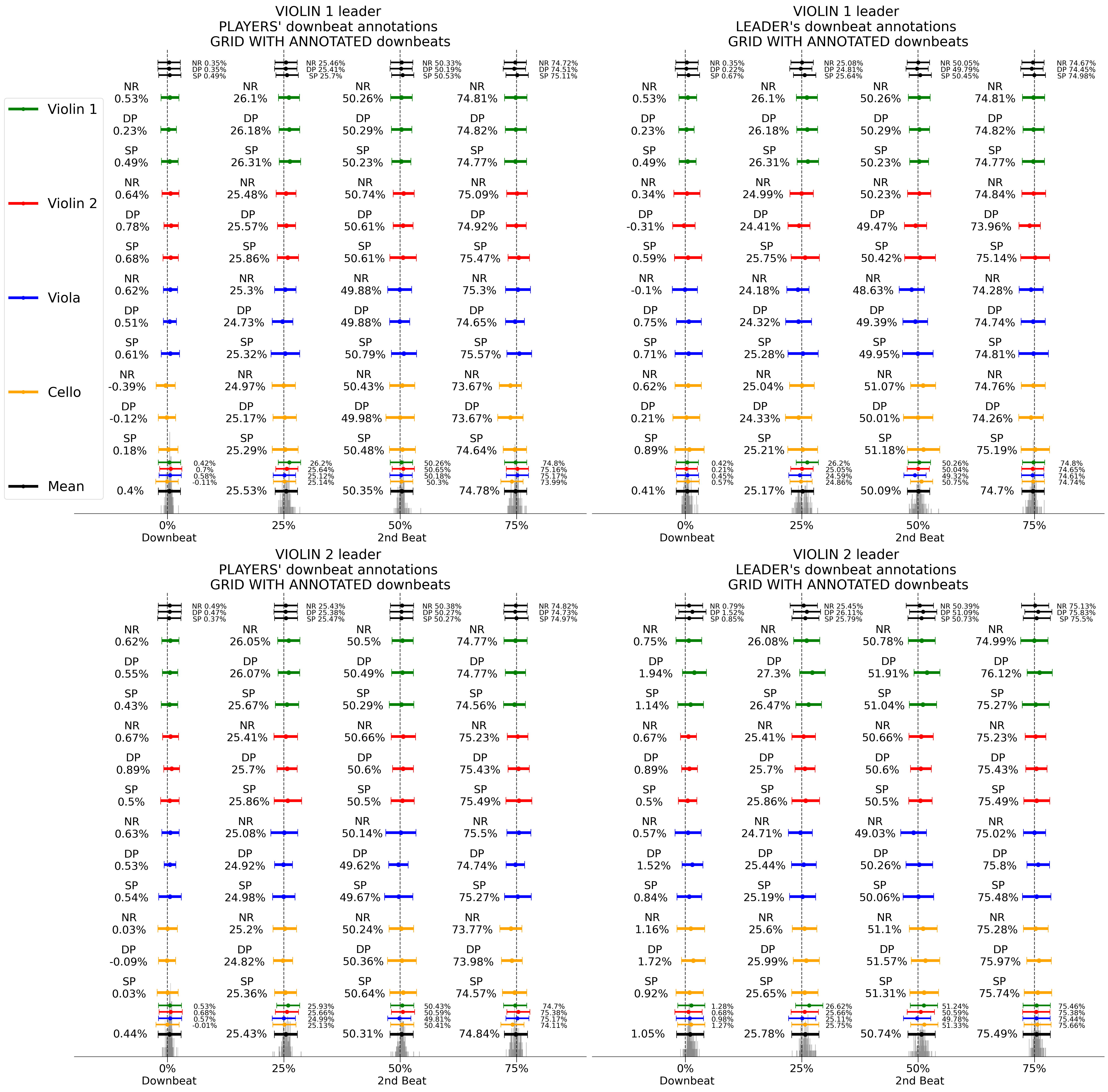Leadership and Performance Styles
The musicians in the string quartet played in three performance styles under the leadership of the first and the second violinists. The performance styles are:
-
— Deadpan (DP) performances with minimal expression in tempo and articulation
-
— Normal (NR) concert style performances
-
— Speed (SP) performances with a spontaneous accelerando and decelerando initiated by the leader once in each performance
Dataset
We use note onset and downbeat annotations for the recordings part of the Virtuoso Strings Dataset.
The musicians in the string quartet played in three performance styles under the leadership of the first and the second violinists. The performance styles are:
-
— 72 performances, total of 288 individual recordings
-
— Virtuoso Strings dataset is available on GitHub
Microtiming Patterns of String Quartet Musicians
Microtiming patterns of four musicians in a quartet can be visualised by quantising note onset positions within an eighth-note metrical structure of bars in a performance. In this study we use Haydn’s Op. 74 No. 1 Finale with the score available here. Each musicians’ annotated note onset positions and downbeat positions are first annotated and then used to visualise microtiming patterns over time.

Figure 1: Microtiming pattern visualisation example for the cello playing Haydn’s Op. 74 Finale.
-
— Note onsets are shown as yellow dots
-
— Onsets include pitch and metrical subdivision labels
-
— Four eighth-notes in a bar are quantised to the
annotated downbeat locations
-
— Metrical grid covers bars 1-48 in 2/4 metre
-
— Vertical dashed blue lines represent means and
standard deviation values
-
— Histograms of onset locations are shown at the
bottom
-
— Means are shown as percentages for each
subdivision in an isochronous metrical grid with values
0%, 25%, 50% and 100%
Microtiming Results
-
— The experiment compares two leadership changes in three performance styles (NR, DP and SP).
-
— Means of microtiming pattern deviations in % are shown per instrument (in colour) for each performance style with additional per-performance style means and per-instrument
means shown above and below plots, respectively.
-
— The experiment investigates microtiming patterns for onsets quantised to the annotated downbeat positions.
-
— All individual results in the following sections use downbeat annotations from the corresponding leader.
First violinist as leader - Deadpan
Per instrument microtiming patterns for performances 1 to 12 in deadpan style. Patterns in the following figures are visualised using annotated downbeats of the designated leader.
First violin
Second violin
Viola
Cello
First violinist as leader - Normal
Per instrument microtiming patterns for performances 1 to 12 in normal style.
First violin
Second violin
Viola
Cello
First violinist as leader - Speed
Per instrument microtiming patterns for performances 1 to 12 in speed style.
First violin
Second violin
Viola
Cello
Second violinist as leader - Deadpan
Per instrument microtiming patterns for performances 1 to 12 in deadpan style.
First violin
Second violin
Viola
Cello
Second violinist as leader - Normal
Per instrument microtiming patterns for performances 1 to 12 in normal style.
First violin
Second violin
Viola
Cello
Second violinist as leader - Speed
Per instrument microtiming patterns for performances 1 to 12 in speed style.
First violin
Second violin
Viola
Cello
Microtiming patterns for annotated downbeat locations.
Mean results for two leaderships and three performance styles. Means of microtiming pattern deviations in % are shown per instrument for each performance style. Additional means per instrument and performance style are shown above and below, respectively.

Conclusions
This study investigated the changes in microtiming patterns of musicians in a string quartet after changing the ensemble's leader. Our analysis revealed reduced microtiming accuracy of each player when new leader's downbeat annotations were used. Specifically, when the musicians were instructed to follow the second and not the first violinist, they played significantly late on every metrical position. Conversely, in a familiar performance context, their synchronisation to the leader's timing was more precise for each metrical position under the leadership of the first violinist. The results highlighted that the presented analysis is a promising approach for studying microtiming in string quartet recordings in future work.
References
Tomczak, M., Li, M.S., Bradbury, A., Elliott, M., Stables, R., Witek, M., Goodman, T., Abdlkarim, D., Di Luca, M., Wing, A. and Hockman, J., 2022. Annotation of Soft Onsets in String Ensemble Recordings. arXiv preprint arXiv:2211.08848.
Böck, S., Krebs, F. and Schedl, M., 2012. Evaluating the Online Capabilities of Onset Detection Methods. In Proceedings of the International Society for Music Information Retrieval Conference (ISMIR).
Böck, S., Krebs, F. and Widmer, G., 2016. Joint Beat and Downbeat Tracking with Recurrent Neural Networks. In Proceedings of the International Society for Music Information Retrieval Conference (ISMIR).
Rocamora, M., Jure, L., Fuentes, M., Maia, L. and Biscainho, L., 2019. CARAT: Computer-Aided Rhythmic Analysis Toolbox. Late-Breaking Demo (LBD) in the International Society for Music Information Retrieval Conference (ISMIR).